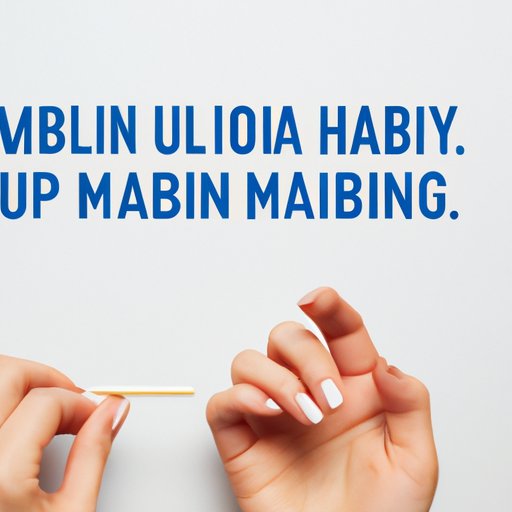Introduction
Nail biting, also known as onychophagia, is an unnerving habit that affects people of all genders and ages. This habit can cause nail biting individuals to feel ashamed, frustrated, and anxious because of the damage to their nails and cuticles, as well as the inability to stop the behavior. Nail biting can also cause health problems by transferring bacteria and viruses from the hands to the mouth. The purpose of this article is to provide practical strategies for breaking the habit of nail biting and offer support for those who are struggling. This article is intended for individuals who want to quit nail biting and transform their lives for the better.
Understand the causes of nail biting and identify your triggers
Nail biting tendencies may be prompted by stress, boredom, anxiety, or even frustration. Some people may bite their nails without even realizing it. To understand this habit, you need to identify why you bite your nails. Start by asking yourself what makes you scratch your nails or chew them. Is it due to anxiety or boredom? Is it due to a nervous habit or a reaction to stress? Try to become more aware of when you are most likely to engage in this habit and what triggers it. Once you have a clear understanding of why you’re biting your nails, you can start taking steps to overcome the habit.
Practice mindfulness to overcome impulsive habits like nail biting
Mindfulness is an effective tool in changing impulsive behaviors like nail biting. Mindfulness can help you increase self-awareness and self-control, two qualities that are important to breaking bad habits. Take a few minutes each day to practice deep breathing exercises, body scan meditation, or gentle yoga. By doing this, you can begin to observe your thoughts and feelings more objectively and with less judgment. When you start having the urge to bite your nails, try taking a moment to breathe deeply, and calmly assess your emotions before acting. Remember, you are more than your habits, and mindfulness can help you find a way out.
Use nail polish designed to discourage nail biting, such as bitter-tasting polishes
If you need some support in quitting the habit, a bitter-tasting nail polish can help. As the name suggests, this nail polish is formulated to taste bitter when applied to the nails, discouraging you from biting them. Several brands of this type of polish are available on the market, such as Mavala Stop, Orly No Bite, and Nails Inc. It’s essential to apply the nail polish regularly and consistently. However, it’s important to remember that the nail polish is not a magic solution for the habit and needs to be used in combination with other strategies.
Replace nail biting with a healthier habit, like chewing gum or playing with a stress ball
One of the best ways to break a habit is to replace it with a healthier one. Choose another habit that satisfies your needs without undermining your health or appearance. Try chewing gum if you have the urge to bite your nails, or consider using a stress ball or fidget cube instead of your fingers. Practice deep breathing or visualization exercises when you start to feel stressed or anxious. Choose a habit that aligns with your goals and preferences and leaves you feeling content and accomplished.
Keep your nails trim, clean, and polished to reduce the urge to bite them
Biting your nails can make them dull, damaged, and unattractive, which can fuel the behavior. However, taking regular care of your nails can help you break the habit. Keep your nails trimmed and clean at all times. Use a nail file or manicure scissors to shape them, and moisturize your hands with lotion to prevent dryness. Use your favorite nail polish to keep them looking nice so you can feel proud of your progress. Choose healthy cuticle oil instead of biting or picking them. When your nails look lovely, you’ll be less tempted to bite them and may also feel more confident about your appearances.
Use visualization techniques to imagine yourself with beautiful, healthy nails
Visualization is a powerful technique that helps you create a mental image of what you want to achieve. It’s a simple way to motivate you to break the habit and keep going during tough times. Try visualizing yourself biting and picking your nails compared to the image of beautiful and healthy nails that you would like to achieve. Picture yourself looking well-groomed and feeling proud of yourself for overcoming the habit. Repeat the visualization exercises regularly to maintain motivation.
Seek support from friends and family or consider therapy to address any underlying emotional or psychological factors that may contribute to your nail-biting habit
If you’re finding it challenging to quit nail biting on your own, consider seeking support from a therapist or counselor who can help you overcome the habit. We all go through difficult times in life, and sometimes handling things alone can be overwhelming and frustrating. Try opening up to your trusted friends and family members who can offer encouragement and accountability. Work with a therapist to help identify any underlying emotional or psychological factors, such as depression, anxiety, or trauma, that may be contributing to your nail-biting habit.
Conclusion
Nail-biting is a tough habit to break, but it’s possible with the right mindset, patience, and strategies. Incorporate mindfulness practices, try healthier habits and visualization exercises, and seek support from family and friends or a therapist. Be consistent and committed to the changes you’ve made, even if it gets challenging. With these strategies, you will be able to quit nail biting and enjoy healthy, beautiful nails.
Remember to be kind and supportive of yourself throughout the process. Celebrate your successes, no matter how small they may seem. With persistence and care, you can overcome this habit and transform your life.
